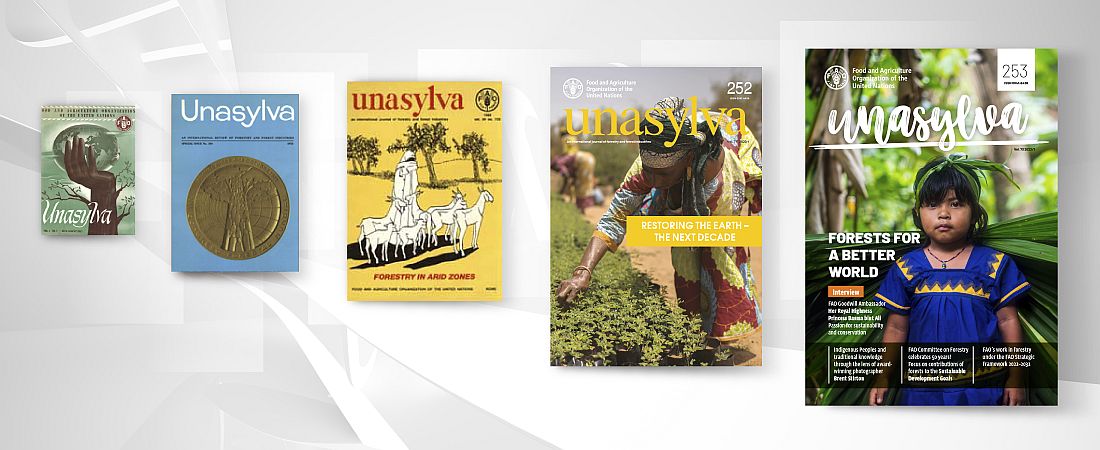Editorial focus and readership
Unasylva is an international journal of forestry and forest industries, produced in separate English, French and Spanish editions. Unasylva covers all aspects of forestry: policy and planning; conservation and management of forest-based plants and animals; rural socio-economic development; species improvement; industrial development; international trade; and environmental considerations, including the role of forests and trees in maintaining a sustainable base for agricultural production at the micro and macro levels as well as the effects of environmental change on forestry.
Articles submitted should be of interest to the broadest possible cross-section of Unasylva's readership, which represents the following groups:
Submission of articles
Unasylva prefers to publish original articles written specifically for the journal, as opposed to papers prepared for presentation or publication elsewhere. The journal occasionally accepts previously published articles if they are judged to be of particular value and have had only limited distribution. Unsolicited manuscripts may be accepted, but authors are encouraged first to submit proposals rather than finished articles.
Unasylva reserves the right to edit all copy as deemed appropriate for length and the overall style of the journal. The Editors will attempt to maintain the style and point of view of the author(s). Wherever possible, the author(s) will be consulted with respect to major changes.
Copy specifications
Articles may be submitted in English, French or Spanish and should be between 2,000 and 4,000 words in length. However, shorter or longer articles may be considered or specifically requested in certain cases. Text should be submitted in electronic format, either on diskette or as an e-mail file attachment. In all cases, the word processing program used should be indicated.
The first page of the article should be a title page, providing the full name, title and contact address (including telephone, fax and e-mail if available) of the author(s) and including a brief abstract or summary of the article. Subsequent pages should be numbered sequentially.
Illustrative material
Authors are encouraged to provide supporting illustrative material with manuscripts. Tables, graphs, maps and drawings should be separate from the body of the text, with the point of reference indicated in the text. For the presentation of quantitative data, graphs are preferred to tables. Authors should provide precise data for the possible re-elaboration of graphs, which should be sent in electronic form. The program in which any graphs or maps are submitted should be indicated.
Photographs are printed in black and white; however, originals may be submitted either as black-and-white or colour prints, negatives, transparencies or high-resolution electronic files. Original material will be returned on request.
Style
Articles should be written in plain, concise language and in a style that is accessible and interesting to forestry professionals in general, and not only to specialists in the topic concerned. Jargon should be avoided and technical terms that may be unfamiliar to readers should be defined the first time they appear. Footnotes should be avoided as far as possible.
Measurement and currency
All measurements should be given in the metric system. When monetary data are mentioned, a conversion to US dollars should be included, based on the current rate at the time the article is submitted.
Abbreviations
Abbreviations and acronyms should be defined the first time they are used; for example, the International Centre for Research in Agroforestry (ICRAF).
Bibliography
Articles should be accompanied by appropriate bibliographies. The name of the author(s) and date of publication should be indicated at appropriate points in the text (e.g. Franklin and Forman, 1987; Viana et al., 1996), with the full reference given in a separate list at the end of the article. Note that the term et al. is used in the text reference when there are four or more authors. However, it should never be used in the bibliography, where all authors must be named.
Example of reference to an article in a periodical:
Franklin, J. & Forman, R. 1987. Creating landscape patterns by forest cutting: ecological consequences and principles. Landscape Ecology, 1(1): 5-11.
Example of reference to a monograph:
Viana, V., Ervin, J., Donovan, R., Elliott, C. & Gholz, H. 1996. Certification of forest products: issues and perspectives. Washington, DC, USA, Island Press.
Example of reference to an Internet document:
Burke, T.E. & Lemon, S.D. 1995. Distributing forest planning information. Rome, FAO. Available at: www.fao.org/waicent/forestinfo/burke/main.htm

